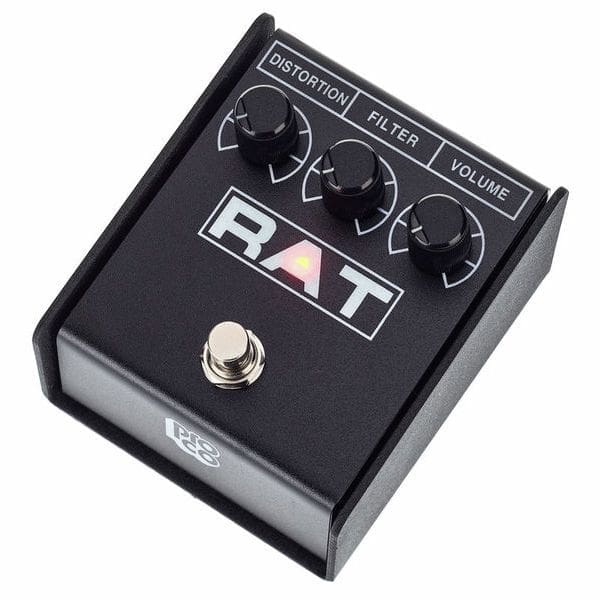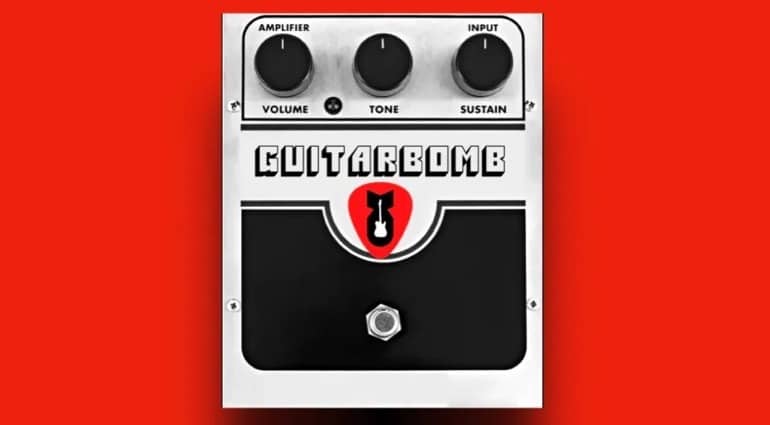This list gives you what I believe are the most flexible, reliable, and readily available stompboxes. If you need a good overdrive or distortion for your guitar setup then this is the list for you and I’ve added a few basic tips to get the most out of each pedal.
Ultimate Drive Tone?
I have a huge collection of pedals myself and have been using pedals for over 35 years. This has given me some great insight into what makes a good drive pedal.
\Many players buy a new pedal and aren’t sure what to do with it. They turn all the controls up to maximum and miss out on all the best tones on offer. I’ll suggest some ways to get better results throughout the list, though I would stress that you really should experiment with those pedal controls, as that is where the magic happens.
Top 5 Distortion & Distortion Pedals
Often we equate a distortion as having more gain, and an overdrive as being less gain-focused, yet great for kicking an already driven amp into distortion. And to some degree, I would agree with these two statements.
Though there are pedals that certainly cross over between the two styles of drive pedals. I’m not going to mention the subcategories of preamps, treble boosters, and fuzz pedals, as I want to keep this article focused to make it easier for beginners and anyone looking for help choosing a great drive pedal. I’ll cover each of these in separate articles, as I think they deserve a separate write-up.
What to look for
Ideally, I look for value for money, a robust solid pedal that will last a lifetime, and finally a great, flexible drive tone. I am not going to include any boutique pedals, as that is a rabbit hole and many of them are based on the pedals in this list.
I’m not anti-boutique pedal, but if you are mid-way through a tour and your pedal needs to be replaced through loss, theft, or breakdown. Then you need something you can buy easily, with no waiting list and an effect you can purchase anywhere in the world.
Proco Rat 2 Distortion
The first drive pedal on my list is the Proco Rat 2 Distortion and it is possibly one of my favorite distortion/overdrive pedals. You could class it as a fuzz at the more extreme settings as well. These pedals are super simple to use and have many great settings that go from subtle to all-out carnage. Which makes them super flexible and great for a variety of guitar amps.

One versatile rodent
The controls on the Rat 2 consist of Distortion, Filter, and Volume and the pedal itself is very robust. That Filter control is the key to getting the best out of the pedal, and as you turn it clockwise it gets darker in tone. As it is a Low Pass filter. The drive tone is all silicon diode hard-clipping on the pre-amplified signal, creating symmetric distortion in a similar way to an MXR Distortion+ or the Boss DS-1.
Don’t hung up by the LM308 op-amp debate, and rather focus on how to dial in the Rat 2. These little black boxes have a ton of great tones available. Subtle tweaks really can open up what is on offer with this circuit so be prepared to tweak your rodent. A good example of a classic distortion tone would be to set the Distortion knob to around noon, the Filter knob to around 10 o’clock, and the Volume to around 2 o’clock.
Link to ProCo Rat 2 on Thomann
Boss DS-1 Distortion
The Boss DS-1 Distortion is a stone-cold classic and has been used on countless recordings, and by guitarists all over the world. It is the go-to drive tone for many players because it is so solid and also very versatile. The simple Level, Distortion, and Tone control layout is easy to use, and super versatile. It also responds well to your playing dynamics, and if you know how to dial it in then it will reward you with superb drive tones.

The Classic
The pedal creates its distortion tones via transistor stages with an op-amp core and hard clipping diodes. The secret with this DS-1 is to avoid high output pickups. It prefers lower output pickups, like vintage-style PAF humbuckers and single coils. The circuit was created in the late ’70s and so these more vintage-style pickup outputs are what it was designed for.
The pedal works well with a slightly dirty amp tone and does not sound good in to a clean amp. I would suggest you leave it on and use your volume knob on your guitar to clean up the distortion tone and think of it more as an extension to your guitar amp. Rather than as a stomp-on-and-off effect pedal. I have seen many players get it very wrong with the DS-1 just because they did not know how to use it.
Tips to dial in the DS-1
- Don’t dime the Tone control all the way up, keep it below the 9 o’clock position for the best tones, or it will bite your head off.
- The Distortion knob is best below the noon position, after that, it becomes messy as it compresses and gets overly saturated.
MXR Distortion +
Making the third place on my list is the classic MXR Distortion + and again, this is a pedal born in the late ’70s. It doesn’t get much simpler and with only two controls, you could be fooled into thinking it is lacking in control. But those two knobs labeled Output and Distortion contain a myriad of amazing drive tones.

Classic Drive Tones
The MXR Distortion + uses germanium diodes and has a different character to the Rat 2 and DS-1 above. This pedal offers soft clipping, The way to get the most out of this MXR is to put it in front of an amp that is already breaking up, and then it will sing. I find the Distortion knob works best between the 10 o’clock and 3 o’clock positions. Then set the Output knob to taste and off you go.
Link to MXR Distortion + on Thomann
Boss BD-2 Overdrive
Number four on my list is the Boss BD-2 Overdrive and this is the first one to offer more restrained subtle drive tones, perfect for players that use single coil pickups. I would describe the pedal as offering a more natural, and vintage tube amp sound. Not as classic rock or hard rock as the previous three stompboxes on my list.

Subtle and Versatile
The BD-2 has three controls Level, Tone, and Gain which offer guitarists some very useable drive tones, with plenty of character. Like most simple control layouts, do not be fooled as there are a lot of tonal variations within this simple-looking blue box. Unlike the DS-1 and the MXR Distortion +. the BD-2 will work well with a clean amp. Below are two settings you could try out to get your results straight away.
- Light Crunch – Try the Level at noon, Tone at 10 o’clock, and Gain around 9 o’clock
- Boost for solos – Level around 5 o’clock, Tone at 11 o’clock, and Gain at 8 o’clock
Link to Boss BD-2 Overdrive on Thomann
Nobels ODR-1 BC
Finally, the Nobels ODR-1 BC is a pedal that offers some great subtle more natural tube amp sounding drive tones. It has a reputation for being a bit of a secret weapon for a lot of session guitarists and many guitarists have used it to create some amazing drive tones.

The Secret Sauce
With controls that consist of Driver, Spectrum, Level, and a Bass Cut switch this little green pedal is potentially the most advanced of the units on this list. Turning the Spectrum knob clockwise increases the bass and treble, at the same time, the midrange stays untouched. Then to further add to the versatility the pedal works with 9-18V DC for more headroom and finally there is also a Remote Output Socket that allows remote control via either an external switch or switcher system.
Tips
Use the Bass Cut switch when working with humbucker-style pickups and the extra headroom offered by 18 V operation is something you should use whenever possible.
The driven sound works well in most settings, but the magic happens in the lower reaches of the drive knob. I also really like that it does not suffer from the mid hump that you would associate with a TubeScreamer-style circuit. In the video below are a few good examples of drive tones, and settings you could try.
Link to Nobels ODR-1 BC on Thomann

No TubeScreamer?
You will have noticed there are two very popular drive pedals missing from my list, The classic Ibanez TubeScreamer and Maxon TubeScreamer style designs, of which there are many. The reason for this is I will be writing about these separately very soon. The TubeScreamer I feel needs a deeper dive, so I will dedicate a whole article to that one. Then there is that little yellow box, that I adore, the Boss SD-1, and its latest Waza Craft edition which expands the circuit further. Again, I have something special planned for that one as well, so be sure to check back for that one.
This article contains affiliate links to Thomann that helps finance the running costs of GuitarBomb. If you buy something through these links, we will receive a small commission. Don’t worry as you pay the exact same price, and it costs you no extra to use these affiliate links for your purchases.

